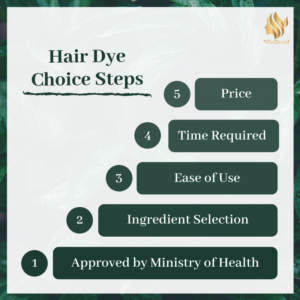5 SIMPLE STEPS TO CHOOSING YOUR
IDEAL HAIR DYE
1. Notified with Authority
Choose products which have been notified or registered with and approved by the relevant authority. The chemical ingredients have been declared to the authority and deemed to have met the regulatory requirements. The manufacturer must have Good Manufacturing Practice (GMP) or equivalent certification.
Products which have been notified and registered with National Pharmaceutical Regulatory Agency (NPRA), Ministry of Health Malaysia have the Notification Number NOTxxxxxxxx, and can be checked here.

2. Ingredient Selection
Choose the ones which have fewer of the more hazardous chemicals as mentioned above, such as Ammonia-Free hair dyes. Next, choose those which have lower concentrations of the more hazardous chemicals, based on the descending order of ingredients shown on the product labelling. Bear in mind though, with this choice the dyeing process may take longer to be effective or more frequent dyeing may be needed or both.
Higher concentrations of natural ingredients would be good for adding colour and/or nourishment to the hair.

3. Ease of Use
Choose the ones which have fewer of the more hazardous chemicals as mentioned above, such as Ammonia-Free hair dyes. Next, choose those which have lower concentrations of the more hazardous chemicals, based on the descending order of ingredients shown on the product labelling. Bear in mind though, with this choice the dyeing process may take longer to be effective or more frequent dyeing may be needed or both.
Higher concentrations of natural ingredients would be good for adding colour and/or nourishment to the hair.
Choose the ones which have fewer of the more hazardous chemicals as mentioned above, such as Ammonia-Free hair dyes. Next, choose those which have lower concentrations of the more hazardous chemicals, based on the descending order of ingredients shown on the product labelling. Bear in mind though, with this choice the dyeing process may take longer to be effective or more frequent dyeing may be needed or both.
Higher concentrations of natural ingredients would be good for adding colour and/or nourishment to the hair.
The types that can be applied as shampoo or combed directly on the hair are easier to use than those which require manual mixing to a certain ratio. The quantity of the colourant and the developer which are to be mixed together, might not be proportional.

4. Time Required for Dye to Work
Hair dyes with chemicals work faster and the dyeing time required is typically less than half-an-hour or even shorter. Generally permanent hair dyes which work in 5 or 10 minutes have higher concentrations of the hazardous chemicals. All-natural hair dyes such as henna without chemicals require longer time definitely.

5. Budget Considerations
While health and safety issues are on everyone’s mind, personal budget is another consideration. Just as we know that the vegetables and fruits we consume every day may have pesticide residues while organic food, if authentic, is worry-free, not everyone can afford the organic choice. Hair dyes which are not 100% natural but have their chemical ingredients at concentrations way below the permissible limits, as approved by the relevant authority, are considered safe alternatives to the all-natural ones.


